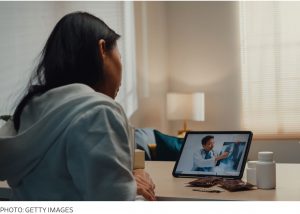It took a viral pandemic to break down the barriers to effective telemedicine, especially across state lines. Now, it seems those barriers are being rebuilt.
Telemedicine, the practice of physicians consulting with patients on the telephone, or more often online with video, became commonplace during the Covid pandemic. Patients, as well as physicians, were reluctant to see people who might be infected with the virus. Therefore, it made perfect sense for patients to stay connected with their doctors through telemedicine since in-office visits were inadvisable. To facilitate these telemedicine evaluations, interstate restrictions were also removed. This enabled physicians to help more and more people during the pandemic, even across state lines.
But now that the pandemic crisis is over, though Covid is still around, some states are reimplementing restrictions on interstate telemedicine. This not only seems petty and unnecessary, but is interfering with access to medicine for some patients, especially those who established interstate doctor-patient relationships during the pandemic.
Shannon MacDonald, a radiation oncologist at Mass General Brigham Hospital in Boston and an associate professor at Harvard Medical School, writes about the impact of these restrictions in an article published in The Wall Street Journal. Dr. MacDonald tells us of a nine-year-old boy from New Jersey she began treating in 2009 with a brain tumor, medulloblastoma. Though the boy and his family traveled between states for appointments, he remained her patient at all times. Telemedicine made it possible for her to answer his parents’ questions, discuss his imaging, and propose new therapies when others failed. He was able to receive state-of-the-art treatment and continuity of care across state lines with the aid of telemedicine.
Though the boy has since died, telemedicine was an integral part of his treatment. You would think that the Covid pandemic would have awakened state governments to the benefits of telemedicine such that the emergency orders permitting interstate treatments would have been permanently waived. But, alas, such is not the case. Some states, like New Jersey (where this boy lived) have rescinded the approval of this practice now that the pandemic crisis is over.
Dr. MacDonald explains: “Instead of enlightening local governments about the benefits of telemedicine, the pandemic highlighted what physicians are forbidden to do. While I never hesitated to pick up the phone to call the boy’s parents and give them advice, I wouldn’t legally be able to do that now because New Jersey has decided that a simple phone call constitutes the practice of medicine. Giving medical advice to an out-of-state patient over the phone can put me at risk of losing my license, and, in states such as California and New Jersey, of criminal charges as well.”
At the outset of the pandemic, some state medical boards feared that telehealth would enable out-of-state doctors to poach patients from local physicians, especially in rural communities. State health authorities also didn’t want the hassle of pursuing malpractice claims across state lines. These concerns were unfounded. Fees and carve-outs—for example, restricting interstate telemedicine to specialty care or requiring referrals—could address these issues without undue limits on access, as could a requirement that physicians adhere to the laws of the state in which the patient is located.
The benefits of telemedicine outweigh any hypothetical concerns. Rural areas lack specialists, but rural residents need specialized healthcare as much as anyone. Distant specialists, accessible to rural residents by phone, shouldn’t be thought of as competitors to rural physicians but as resources capable of extending patients’ lives.
Personally, I have never understood why physicians are not granted the privilege to practice medicine in all 50 states when they pass the National Board of Medical Examiners test, which is required by every state for licensure in the U.S. I’m sure the reason has more to do with collecting state licensure fees than with any concerns about qualifications to practice medicine. I’m sure most doctors would be happy to pay a little more for national licensure, which could be shared with other states. In turn, these states would save money because they wouldn’t have to license these physicians themselves. This is an issue that has more to do with state control and fees than it does with qualifications.
Dr. MacDonald has tried to overcome this hurdle to interstate telemedicine. She explains:
“Without interstate telehealth, I’d have to become licensed in all the states where my patients live if I wanted to continue treating their rare childhood cancers or bone tumors. Because I believe strongly in the benefits of telehealth, I have obtained licenses in six states through the Interstate Medical Licensure Compact. Doing this took months, cost thousands of dollars, and still leaves me unable to care virtually for patients in 43 states. The process is so cumbersome that less than 1% of physicians use it.”
“Military doctors have long been able to practice medicine across state lines. In 2018 it became legal for sports-team doctors to practice medicine during out-of-state away games. If we can make a law that allows treatment across state lines for a National Football League player, can’t we consider it for a child with a brain tumor?”
This is clearly a problem begging for a solution that is in the hands of politicians, not doctors. The time has come for the politicians to make it easier to practice the best possible medicine. Some day those politicians may need access to interstate physicians themselves.


